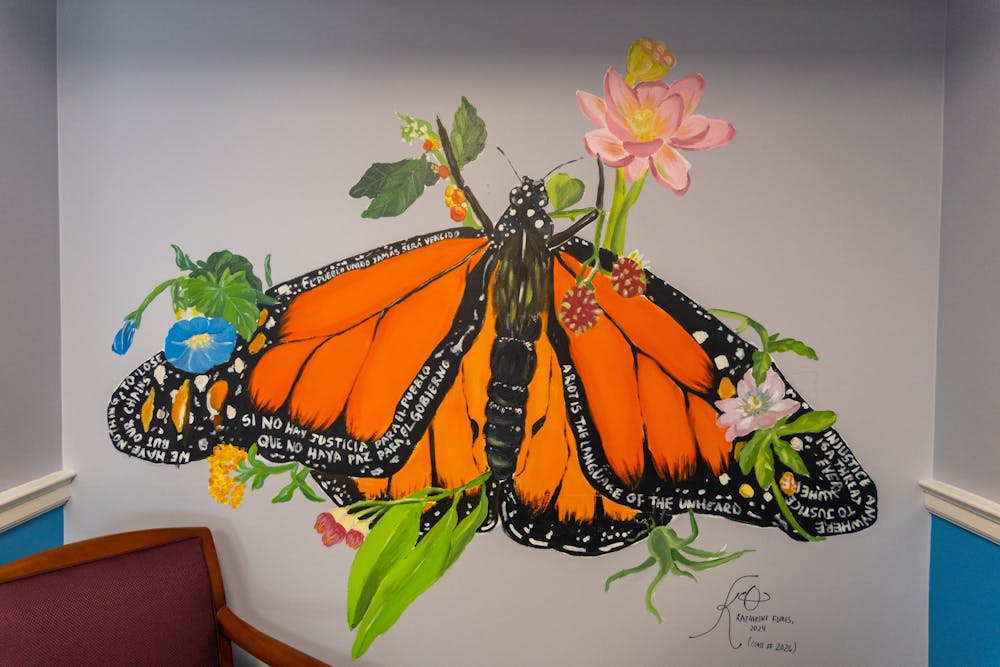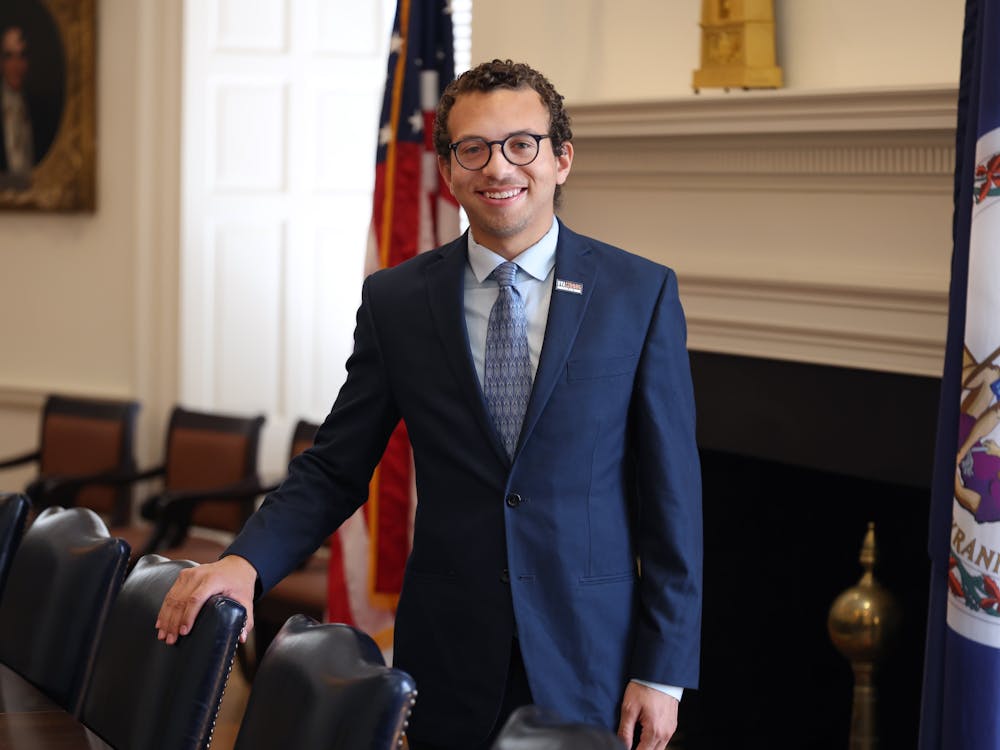On the fourth floor of Newcomb Hall, a monarch butterfly welcomes students into the newly renovated office for Student Legal Services. The majestic monarch adorned with exotic flora is the centerpiece of the SLS’s new office mural, created by second-year Nursing student Katherine Flores to reflect the intricacies of immigration law and students’ journeys through the United States legal system.
SLS, established in 1972, offers low-cost and confidential legal advising and representation to University students. SLS mainly assists students with housing and criminal issues, guiding students who have often never encountered the law on their own. Throughout the month of February, Flores has worked tirelessly to design and paint the mural for the SLS office, drawing inspiration from her own complicated relationship with the United States legal system after immigrating from El Salvador as a child.
At the center of the mural is a large monarch butterfly, based on a metaphor from Flores’ favorite book “On Earth We’re Briefly Gorgeous” by Ocean Vuong. Vuong compares monarch butterflies to immigrants, as they both undergo migratory journeys and their offspring reap the benefits of this hard work. Flores explains that since many families, including her own, arduously immigrated to the U.S., their children — University students — are the ones who are not only able to pursue an education but are also able to act as advocates for change in our legal system.
“‘I was really inspired by [Vuong’s metaphor] because most of my friends’ parents are immigrants, and they had a very obstacle-filled journey to get here — even being in the U.S. was very hard,” Flores said. “I just wanted to really represent that side of the legal system and also how students are the ones who are advocating for change.”
Flores said that she did not have a positive experience with the United States judicial system in her own process of immigrating to the U.S. However, she recognizes her green card as a privilege because without it, she would not be eligible for financial aid at the University, as undocumented students are not eligible for institutional aid.
“Even after I was allowed to enter [the U.S.], I still had to go through a very tedious process just to get even a social security number,” Flores said. “Thankfully, now I have a green card, which is a huge privilege to have, but it’s still not the biggest step to become a U.S. citizen.”
Rather than focusing on the negative legal issues faced by immigrants and people of color — such as unequal treatment at trials and police brutality — Flores highlights the colorful, resilient passion that fuels change for those issues in hopes of sparking conversation among students who seek SLS’s services. Flores’ design also represents SLS’s aim to ameliorate students’ relationships with the legal system, making the law into a tool rather than a form of punishment.
Flores draws upon experiences with immigration that are close to her own heart — including her mother’s period of house arrest and her friends’ experiences with their undocumented parents — in hopes that her message will resonate with other students struggling to navigate the legal system. She acknowledges the turmoil she and other students have experienced, but ultimately she communicates their resilience and determination through the various plant species in her mural.
“Throughout the mural, I have flowers that have negative connotations to them because they’re invasive or hard to get rid of,” Flores said. “I thought that as immigrants, we tend to have a lot of negative connotations, yet we’re able to thrive in such harsh environments.”
Some of these plants represent the specific experiences of her close friends. The lotus represents her friend from India, while her friend from Peru asked Flores to include a eucalyptus leaf and coffee plant from South America. According to Flores, this diversity in plant origins thoughtfully reflects the diversity in the University’s student body.
SLS director Teresa Hepler expands upon Flores’ message of resilience. As Flores started to bring her vision to life, Hepler advised Flores by suggesting that she include a mix between invasive and Virginia native plant species to represent the coexistence of students born in the U.S. and those born in foreign countries.
According to Hepler, students are in a vulnerable legal position, as many attend school on student loans and rent from landlords who may take advantage of them. With the help of SLS, Hepler said she sees students as the resilient “underdog rising above through the legal system,” even if the experience can be difficult.
Further, Hepler said that the experience can be exceedingly stressful for immigrants and students of color, which Hepler connects to her own identity as a Black woman.
“With [Flores’] mural, it talks about invasive species as being a metaphor for people who don’t belong,” Hepler said. “As somebody who is a person of color — especially given Black people’s history with the legal system — I feel that resonated with me.”
One invasive species from the mural explained by Hepler is the butterfly weed, a monarch butterfly’s main diet. Another is the purple passionflower, a plant native to both Virginia and South America, tying the two locations together through one commonality.
“The other [Virginia native plant included] is a purple passion flower, which is native to Virginia and has another version in South America, like the passion fruit that you probably see in grocery stores,” Hepler said. “I figured since it was kind of a vine, it could be welcoming and intersecting with the so-called invasive species.”
Like the milkweed entwined with the purple passionflower, Hepler hopes the mural will welcome and comfort students who seek SLS’s services.
“There can be trauma involved with whatever experience you’ve had, so a legal case can often help you rise above that and heal,” Hepler said.
Hepler, along with SLS’s Board of Advisors, selected Flores’ design after an application process that solicited student-created designs for the new mural. According to Hepler, the Board is composed of five Student Council members, an SLS intern, two student affairs administrators, a Charlottesville attorney, an adjunct law professor and a history professor. The Board voted unanimously in favor of Flores’ design, revealing student and community support for her creative representation of the law.
There is no question why the Board was in agreement about Flores’ mural. The piece flawlessly captures the complexity of students’ expository journeys through the legal system and boldly stands for the University students who are working to change it — all with the flutter of a wing and a pop of color.







